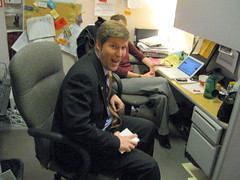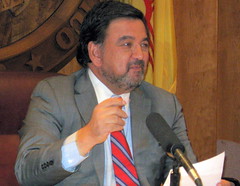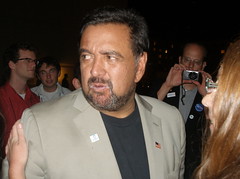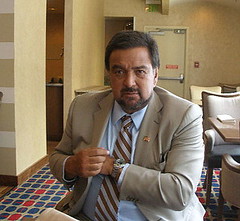A version of this was published in The Santa Fe New Mexican
Nov. 11, 2012
All the sound and fury of attacks ads and the millions of dollars spent by PACs and super-PACs are over. And as far as the state Legislature is concerned, what we basically have as the dust settles is a Roundhouse in which Democrats — originally feared to be in danger — end up with a slightly stronger hold on the House of Representatives while not significantly weakened in the Senate.
 |
| Javier Gonzales |
But a new dynamic might be about to unfold. Two Democrats in recent days have told me that they expect the Legislature to start taking the initiative to set the state’s agenda — as opposed to the governor taking the lead in coming up with legislation, as has been the case in recent years.
On election night, state Democratic Party Chairman Javier Gonzales told me, “Democratic leaders [in the Legislature] will be involved in producing critical legislation for New Mexico.”
Gonzales said that while Republican Gov. Susana Martinez was successful in her quest to defeat Senate President pro-tem Tim Jennings, D-Roswell, she failed to take out her other major target, Majority Leader Michael Sanchez of Belen, and had weakened her relationship with the Legislature as a whole.
Later in the week, Sen. Tim Keller, D-Albuquerque, who won re-election to a second term, had similar thoughts. “I think we’re going to find [the Legislature] returning to the traditional way of doing things — where the Legislature sets the agenda and sends bills to the governor.”
 |
| Sen. Tim Keller |
Of course, the Legislature always sends lots of bills of its own to the governor, who can sign or veto what she pleases. But Keller noted that starting with Gov. Bill Richardson in 2003, the governor’s agenda became the primary focus of legislative sessions.
Gov. Martinez has continued that role, Keller said. Generally, she sends bills down to the Legislature, which, in effect, “signs” or “vetoes” her proposals.
Will the Democratic caucuses in the House and Senate be united enough to retake these reins? “I don’t know,” Keller said. “There will be so many freshmen, that’s the wild card.”
Indeed, because of retirements and election defeats, there will be 15 new senators (that’s more than a third) and at least 20 new members of the 70-member House (the numbers there aren’t final yet because of a pending recount in one race).
But even if the Legislature seizes the agenda, there’s one inconvenient constitutional fact. The governor has the power to veto. Gov. Gary Johnson took pride in vetoing hundreds of bills. And when he ran for re-election in 1998, that sure didn’t hurt his popularity.
So we might just end up with a different kind of Roundhouse gridlock.
You can’t go home again: Two former House members from Las Cruces, Nate Cote and Jeff Steinborn, are getting second chances in the Legislature. Both Democrats lost in the Republican sweep of 2010 but were successful this time. Cote defeated Ricky Little, the Republican who beat him two years ago.
However, three Albuquerque senators attempting to make a comeback fell short.
Shannon Robinson was a Democrat who switched to Republican (although we know that in his heart, he’ll always be a “Bull Moose,” as he sometimes described himself). He lost to Keller, who beat him in the 2008 Democratic primary.
Joe Carraro, a former Republican, changed his registration to declined-to-state. He was defeated by Republican John Ryan. We declined-to-states might be the fastest growing segment in terms of voting registration in the state, but we didn’t do well at the ballot box Wednesday. The only other independent running for Legislature, Rep. Andy Nuñez of Hatch, came in third in the District 36 race, losing his seat to Democrat Felipe Archuleta.
The third former senator to loose a comeback bid was Diane Snyder. She lost her seat in 2008 to Democrat Tim Eichenberg. She lost Tuesday to incoming freshman Daniel Ivey-Soto.




















